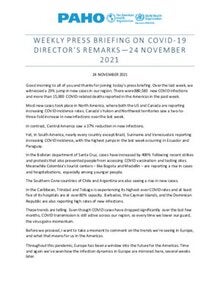Weekly Press Briefing on COVID-19: Director's Opening Remarks, November 24, 2021

|
Good morning to all of you and thanks for joining today’s press briefing. Over the last week, we witnessed a 23% jump in new cases in our region. There were 880,583 new COVID infections and more than 15,000 COVID-related deaths reported in the Americas in the past week. Most new cases took place in North America, where both the US and Canada are reporting increasing COVID incidence rates. Canada’s Yukon and Northwest territories saw a two-to-three-fold increase in new infections over the last week. In contrast, Central America saw a 37% reduction in new infections. Yet, in South America, nearly every country except Brazil, Suriname and Venezuela is reporting increasing COVID incidence, with the highest jumps in the last week occurring in Ecuador and Paraguay. In the Bolivian department of Santa Cruz, cases have increased by 400% following recent strikes and protests that also prevented people from accessing COVID vaccination and testing sites. Meanwhile Colombia’s tourist centers – like Bogota and Medellin – are reporting a rise in cases and hospitalizations, especially among younger people. The Southern Cone countries of Chile and Argentina are also seeing a rise in new cases. In the Caribbean, Trinidad and Tobago is experiencing its highest-ever COVID rates and at least five of its hospitals are at over 80% capacity. Barbados, the Cayman Islands, and the Dominican Republic are also reporting high rates of new infections. These trends are telling. Even though COVID cases have dropped significantly over the last few months, COVID transmission is still active across our region, so every time we lower our guard, the virus gains momentum. Before we proceed, I want to take a moment to comment on the trends we’re seeing in Europe, and what that means for us in the Americas. Throughout this pandemic, Europe has been a window into the future for the Americas. Time and again we’ve seen how the infection dynamics in Europe are mirrored here, several weeks later. And over the last weeks, many European countries have reported record numbers of new cases. In eastern Europe, relatively lower vaccination coverage has led to an increase in cases. While many Western European countries have achieved substantial vaccination coverage, they still have significant pockets of unvaccinated people. And in many cases, public health measures have been relaxed, creating the perfect environment for this virus to spread. The future is unfolding before us, and it must be a wakeup call for our region because we are even more vulnerable. While 51% of people across Latin America and the Caribbean have been fully vaccinated against COVID-19, there are 19 countries in our region that have not reached the WHO targets to vaccinate 40% of the population of every country by the end of this year and 70% by mid-2022. Even though vaccination coverage is not as high as we’d hope, in many densely populated areas of the Americas, preventive measures have been lifted or relaxed. This is a worrisome combination that keeps us vulnerable to the virus and threatens our hard-fought gains. With the approaching holidays and upcoming summer vacations in the Southern Hemisphere, I wish to take a moment to remind everyone that our individual and collective decisions chart the path of this pandemic. We have been here before. Our region witnessed a large jump in new cases following last year’s holiday season and it took months for countries to reduce the incidence of new cases. This year, we are better off than the last for one simple reason: we have more tools to protect ourselves from this virus. That’s why today I want to urge two main messages. The first, is that vaccines work. The WHO has authorized eight COVID-19 vaccines that are safe and effective against this virus. Other vaccines have also been approved by national regulatory authorities in several countries. Our hospitals offer the best proof of the power of these vaccines. Mere months ago, hospital beds and intensive care units across our region were at capacity, leaving many COVID patients with nowhere to turn. But over the last year, more than 1.3 billion COVID-19 vaccine doses have been administered in the Americas, giving us protection against serious COVID illness that would often require hospitalization. As we’ve seen in the US, Chile, Cuba, Uruguay, Canada, Panama, El Salvador, and other countries where most of the population is immunized, these vaccines have helped lower hospital bed occupancy. PAHO is working to expand vaccine access in the region, especially in places that are falling behind. But vaccines are not the only tool to protect us against COVID. That’s why the last point I want to stress is that public health measures are key to reducing the spread of this virus. Mask wearing, social distancing and avoiding large gatherings, especially indoors, will remain important – even as more of us get vaccinated. There is no room for complacency because we’ve already faced the consequences of an uncontrolled pandemic and we don’t want to be in that position again. As we enter the time of year for reflection and celebration, give a gift to your friends and family by getting vaccinated when it’s your turn. If you’re planning on seeing loved ones this season, keep your gatherings small – to the extent possible – and outdoors when you can. If you must gather inside, open your windows so air can circulate. For anyone who is planning to pack their bags, please get vaccinated before you leave. And don’t forget to wear a mask during your trip and follow the public health guidance at your destination. The decisions we take over the next few months will determine the course of the next year. It is really up to all of us to make smart and safe choices this holiday season so we can protect ourselves and each other from this virus. |
